24 horas híbridas de Toyota 2016: así las vivimos
Los días 4 y 5 de octubre coches.com disputó por segundo año consecutivo las 24 horas híbridas de Toyota, una competición tipo LeMans donde se premia la fiabilidad, el dinamismo y la regularidad. El lugar elegido para disputar la carrera fue el mismo que el año pasado, el Circuito de Albacete, un trazado de 3,5 kilómetros que cuenta con 14 curvas, 8 en sentido derecho y 6 restantes en sentido izquierdo
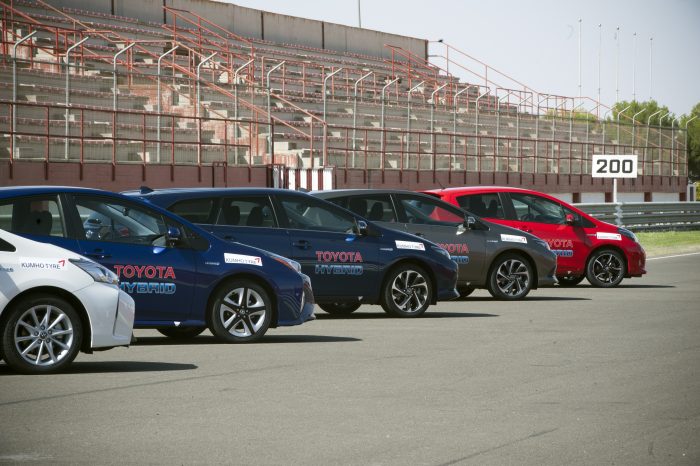
También hubo cambios en el reglamento, este año los tiempos por vuelta estaban limitados, se tenían que hacer en unos tiempos de entre 2:30 y 3:10, de lo contrario, se penalizaba con una vuelta menos en el cómputo global. Quizás esta norma hizo algo más aburrida la carrera, dado que el año pasado se marcó la vuelta rápida en 2 minutos y 12 segundos, casi veinte segundos de diferencia.
Otra de las novedades presentes en esta edición fue el proveedor de neumáticos, ya no era Michelin, sino Kumho, una marca menos conocida (que no menos importante), presente en 180 países y que ya ha fabricado más de sesenta y nueve millones de neumáticos, se dice pronto.
Pero la gran diferencia respecto al año pasado eran los coches, a diferencia del año pasado donde solo disponíamos del Toyota Auris Hybrid, en esta edición participaban los seis modelos de la gama híbrida de Toyota: Yaris, Auris, Auris TS, Prius, Prius+ y RAV4. Cada equipo tenía cuatro horas para rodar con cada modelo, a las 3 horas 40 minutos se debía de entrar al PIT para hacer el cambio de neumáticos delanteros y el repostaje.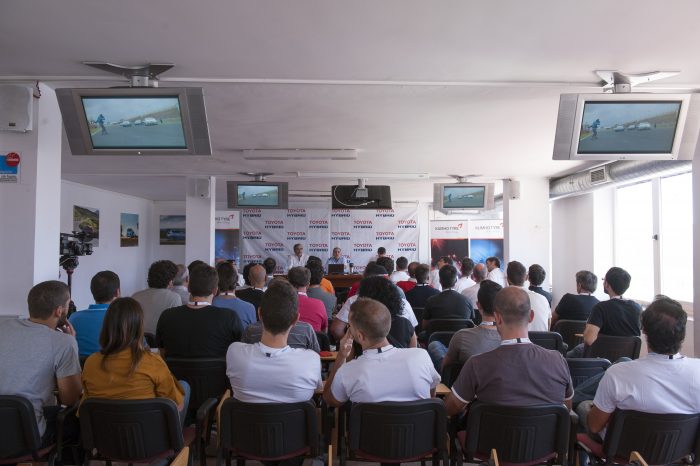

Una vez terminado el briefing, era hora de reunirse con los demás miembros del equipo y planear la estrategia a seguir durante la carrera. En esta ocasión, mi equipo era el número 6 y estaba compuesto por profesionales de los siguientes medios: Autopista, Garage TV, Coches.net y Pistonudos. La estrategia era sencilla, gastar lo menos posible y hacer vueltas dentro del intervalo de tiempo establecido en el reglamento para no penalizar. Además, establecimos el turno de conducción de cada uno, yo sería el último en conducir cada coche, por lo que sería el encargado de cruzar la bandera a cuadros el día 5.
Primera tanda: RAV4
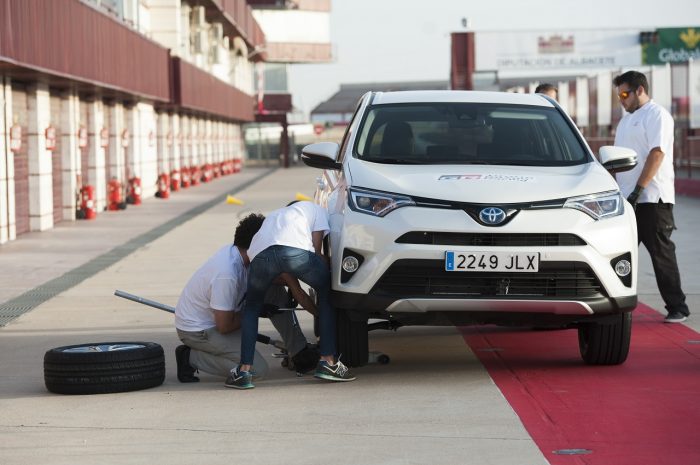
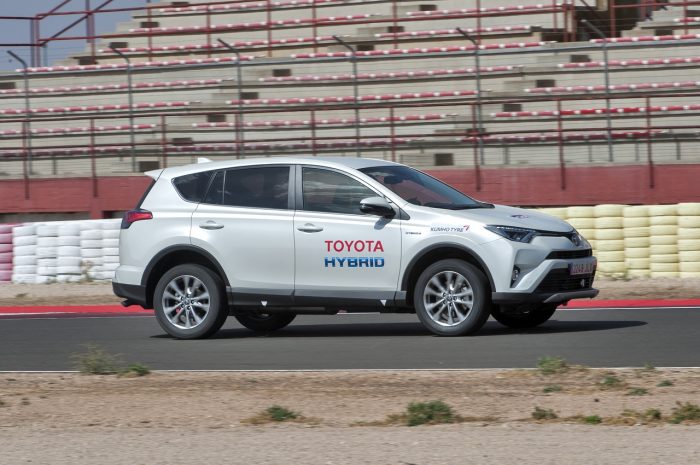
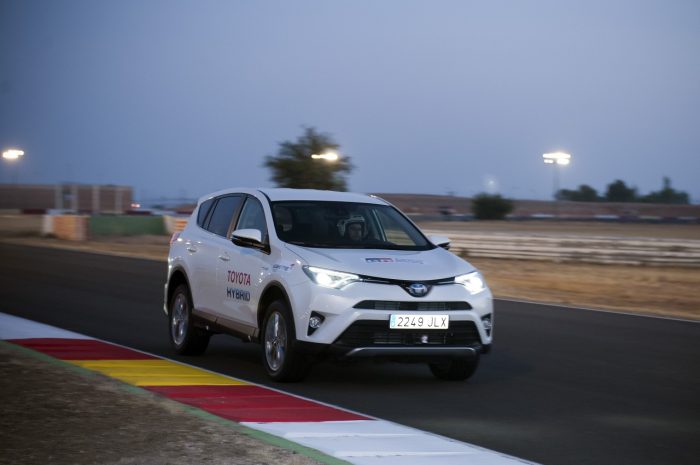
A las 15:00 horas del 4 de octubre se dio el pistoletazo de salida, ya había empezado la cuenta atrás hasta el día siguiente. Para esta primera parte de carrera nos tocó (por sorteo) el Toyota RAV-4 Hybrid, un SUV con motor térmico 2.5 VVT-i de 152 CV combinado con un motor eléctrico de 143 CV, para dar una potencia combinada de 197 CV de potencia.
Al llegar mi turno, me encontré un consumo de 8,7 l/100 km, una cifra bastante elevada si tenemos en cuenta que no superamos los 90 km/h en todo el circuito, por lo que me dedique a intentar rebajar esa cifra ¿Cómo? Haciendo aceleraciones muy progresivas, aprovechando al máximo el motor eléctrico y recargándolo en las desaceleraciones. Pasados los 50 minutos de conducción rebajé esa cifra a 8,4 l/100 km. Una cifra que aún así, seguía siendo alta para la velocidad a la que se circulaba en pista. Pero bueno, no había nada perdido todavía, faltaban muchas horas para recuperar consumos respecto a otros equipos, además ya nos habíamos quitado el coche que más gasta de los seis.
En cuanto a sensaciones de conducción no me dejó satisfecho al cien por cien, pero es normal, el RAV-4 se siente más a gusto en otro tipo de terrenos. Al trazar las curvas el coche tendía a irse de morro, los 1650 kilos de peso se hacían notar a la hora de hacer movimientos bruscos. Sin embargo, la postura de conducción elevada es muy agradable, te otorga esa sensación de amo y señor del circuito.
-------------------------------
On October 4 and 5, autos.com competed for the second consecutive year in Toyota's hybrid 24 hours, a LeMans competition that rewards reliability, dynamism and regularity. The place chosen to dispute the race was the same as last year, the circuit of Albacete, a track of 3.5 kilometers that has 14 curves, 8 in the right and 6 left
In this edition the Japanese brand decided to make some changes in search of more adjusted consumption. If last year won the most lap with 125 liters of gasoline, this year the thing was quite different, won the one that obtained the best final note of the following operation: 65% of the note was obtained from the average consumption and, the Remaining 35%, of the laps realized.A031
There were also changes in the regulations, this time lap times were limited, had to be done in a time between 2:30 and 3:10, otherwise, was penalized with one lap less in the overall count. Maybe this rule made the race a little more boring, given last year's fast lap in 2 minutes and 12 seconds, almost twenty seconds apart.
Another new feature in this edition was the tire supplier, it was no longer Michelin, but Kumho, a brand less known (not less important), present in 180 countries and has already manufactured more than sixty-nine million tires , Is said soon.
But the big difference compared to last year was cars, unlike last year where we only had the Toyota Auris Hybrid, this year participated the six models of the hybrid range of Toyota: Yaris, Auris, Auris TS, Prius, Prius + and RAV4. Each team had four hours to roll with each model, at 3 hours 40 minutes was to enter the PIT to do the change of front tires and refueling.A015
Once the briefing was over, it was time to meet with the other team members and plan the strategy to follow during the race. On this occasion, my team was number 6 and was made up of professionals from the following media: Autopista, Garage TV, Coches.net and Pistonudos. The strategy was simple, to spend as little as possible and to make laps within the interval of time established in the regulation not to penalize. In addition, we established the driving shift of each, I would be the last to drive each car, so I would be in charge of crossing the checkered flag on day 5.
First batch: RAV4
Toyota RAV4
Toyota RAV4 2
Toyota RAV4 1
At 3:00 p.m. on October 4, the kick-off was started, the countdown had begun until the following day. For this first part of the race we were (by drawing) the Toyota RAV-4 Hybrid (see test), a SUV with thermal engine VVT-i of 152 hp combined with a 143 hp electric motor, to give a combined power of 197 hp power.
When I arrived my shift, I found a consumption of 8.7 l / 100 km, a figure quite high if we consider that we do not exceed 90 km / h in the whole circuit, so I dedicate myself to try to reduce that figure? How? Making very accelerating accelerations, taking full advantage of the electric motor and recharging it in the decelerations. After the 50 minutes of driving I reduced that figure to 8.4 l / 100 km. A figure that still remained high for the speed at which it was circulated on the track. But, well, there was nothing lost yet, many hours to recover consumption compared to other teams, and we had already taken the car that spends the most of the six.
As for driving sensations did not leave me satisfied 100%, but it is normal, the RAV-4 feels more at ease in another type of terrain. When drawing the curves the car tended to go off the nose, the 1650 kilos of weight were made notice when making sudden movements. However, the posture of elevated driving is very pleasant, it gives you that feeling of master and master of the circuit.
No comments:
Post a Comment